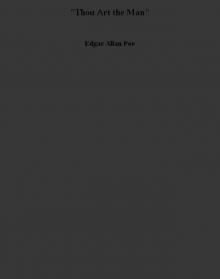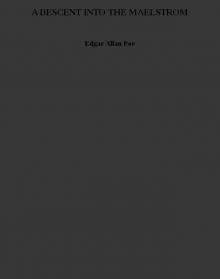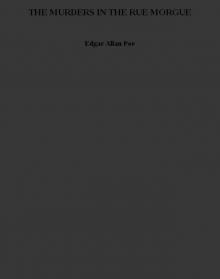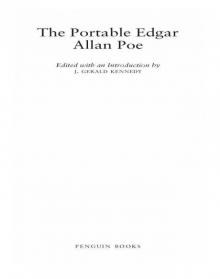- Home
- Edgar Allan Poe
The Science Fiction of Edgar Allan Poe (Penguin Classics) Page 15
The Science Fiction of Edgar Allan Poe (Penguin Classics) Read online
Page 15
We looked at the picture which he presented. I saw nothing in it of an extraordinary character; but its effect upon Bedloe was prodigious. He nearly fainted as he gazed. And yet it was but a miniature portrait – a miraculously accurate one, to be sure – of his own very remarkable features. At least this was my thought as I regarded it.
‘You will perceive,’ said Templeton, ‘the date of this picture – it is here, scarcely visible, in this corner – 1780. In this year was the portrait taken. It is the likeness of a dead friend – a Mr Oldeb 9 – to whom I became much attached at Calcutta, during the administration of Warren Hastings. I was then only twenty years old. – When I first saw you, Mr Bedloe, at Saratoga, it was the miraculous similarity which existed between yourself and the painting, which induced me to accost you, to seek your friendship, and to bring about those arrangements which resulted in my becoming your constant companion. In accomplishing this point, I was urged partly, and perhaps principally, by a regretful memory of the deceased, but also, in part, by an uneasy, and not altogether horrorless curiosity respecting yourself.
‘In your detail of the vision which presented itself to you amid the hills, you have described, with the minutest accuracy, the Indian city of Benares, upon the Holy River. The riots, the combats, the massacre, were the actual events of the insurrection of Cheyte Sing, which took place in 1780,10 when Hastings was put in imminent peril of his life. The man escaping by the string of turbans, was Cheyte Sing himself. The party in the kiosk were sepoys and British officers, headed by Hastings. Of this party I was one, and did all I could to prevent the rash and fatal sally of the officer who fell, in the crowded alleys, by the poisoned arrow of a Bengalee. That officer was my dearest friend. It was Oldeb. You will perceive by these manuscripts,’ (here the speaker produced a note-book in which several pages appeared to have been freshly written) ‘that at the very period in which you fancied these things amid the hills, I was engaged in detailing them upon paper11 here at home.’
In about a week after this conversation, the following paragraphs appeared in a Charlottesville paper.
‘We have the painful duty of announcing the death of Mr AUGUSTUS BEDLO, a gentleman whose amiable manners and many virtues have long endeared him to the citizens of Charlottesville.
‘Mr B., for some years past, has been subject to neuralgia, which has often threatened to terminate fatally; but this can be regarded only as the mediate cause of his decease. The proximate cause was one of especial singularity. In an excursion to the Ragged Mountains, a few days since, a slight cold and fever were contracted, attended with great determination of blood to the head. To relieve this, Dr Templeton resorted to topical bleeding. Leeches were applied to the temples. In a fearfully brief period the patient died, when it appeared that, in the jar containing the leeches, had been introduced, by accident, one of the venomous vermicular sangsues12 which are now and then found in the neighboring ponds. This creature fastened itself upon a small artery in the right temple. Its close resemblance to the medicinal leech caused the mistake to be overlooked until too late.
‘N.B. The poisonous sangsue of Charlottesville may always be distinguished from the medicinal leech by its blackness, and especially by its writhing or vermicular motions, which very nearly resemble those of a snake.’
I was speaking with the editor of the paper in question, upon the topic of this remarkable accident, when it occurred to me to ask how it happened that the name of the deceased had been given as Bedlo.13
‘I presume,’ said I, ‘you have authority for this spelling, but I have always supposed the name to be written with an e at the end.’
‘Authority? – no,’ he replied. ‘It is a mere typographical error. The name is Bedlo with an e, all the world over, and I never knew it to be spelt otherwise in my life.’
‘Then,’ said I mutteringly, as I turned upon my heel, ‘then indeed has it come to pass that one truth is stranger than any fiction – for Bedlo, without the e, what is it but Oldeb conversed? And this man tells me it is a typographical error.’
The Balloon-Hoax
ASTOUNDING
NEWS!
BY EXPRESS VIA NORFOLK!
THE
ATLANTIC CROSSED
in
THREE DAYS!
Signal Triumph
of
Mr Monck Mason’s
FLYING
MACHINE!!!!1
Arrival at Sullivan’s Island2
near Charleston, S. C.
of Mr Mason, Mr Robert
Holland, Mr Henson, Mr
Harrison Ainsworth, and
four others, in the Steer-
ing Balloon ‘Victoria’ –
After a passage of
Seventy-Five Hours
From Land to Land!
Full Particulars of the Voyage!*
THE great problem is at length solved! The air, as well as the earth and the ocean, has been subdued by science, and will become a common and convenient highway for mankind. The Atlantic has been actually crossed in a Balloon! and this too without difficulty – without any great apparent danger – with thorough control of the machine – and in the inconceivably brief period of seventy-five hours from shore to shore! By the energy of an agent at Charleston, S.C.,3 we are enabled to be the first to furnish the public with a detailed account of this most extraordinary voyage, which was performed between Saturday, the 6th instant, at 11, A.M., and 2, P.M., on Tuesday, the 9th instant, by Sir Everard Bringhurst; Mr Osborne, a nephew of Lord Bentinck’s; Mr Monck Mason and Mr Robert Holland, the well-known aeronauts; Mr Harrison Ainsworth, author of ‘Jack Sheppard’, &c.;4 and Mr Henson, the projector of the late unsuccessful flying machine 5 – with two seamen from Woolwich – in all, eight persons. The particulars furnished below may be relied on as authentic and accurate in every respect, as, with a slight exception, they are copied verbatim from the joint diaries of Mr Monck Mason and Mr Harrison Ainsworth, to whose politeness our agent is also indebted for much verbal information respecting the balloon itself, its construction, and other matters of interest. The only alteration in the MS. received, has been made for the purpose of throwing the hurried account of our agent, Mr Forsyth, in a connected and intelligible form.
THE BALLOON
Two very decided failures, of late – those of Mr Henson and Sir George Cayley – had much weakened the public interest in the subject of aerial navigation. Mr Henson’s scheme (which at first was considered very feasible even by men of science,) was founded upon the principle of an inclined plane, started from an eminence by an extrinsic force, applied and continued by the revolution of impinging vanes, in form and number resembling the vanes of a windmill. But, in all the experiments made with models at the Adelaide Gallery, it was found that the operation of these fans not only did not propel the machine, but actually impeded its flight. The only propelling force it ever exhibited, was the mere impetus acquired from the descent of the inclined plane; and this impetus carried the machine farther when the vanes were at rest, than when they were in motion – a fact which sufficiently demonstrates their inutility; and in the absence of the propelling, which was also the sustaining power, the whole fabric would necessarily descend. This consideration led Sir George Cayley to think only of adapting a propeller to some machine having of itself an independent power of support – in a word, to a balloon; the idea, however, being novel, or original, with Sir George, only so far as regards the mode of its application to practice. He exhibited a model of his invention at the Polytechnic Institution. The propelling principle, or power, was here, also, applied to interrupted surfaces, or vanes, put in revolution. These vanes were four in number, but were found entirely ineffectual in moving the balloon, or in aiding its ascending power. The whole project was thus a complete failure.
It was at this juncture that Mr Monck Mason (whose voyage from Dover to Weilburg in the balloon, ‘Nassau’,6 occasioned so much excitement in 1837,) conceived the idea of employing the principle of the Archime
dean screw for the purpose of propulsion through the air – rightly attributing the failure of Mr Henson’s scheme, and of Sir George Cayley’s,7 to the interruption of surface in the independent vanes. He made the first public experiment at Willis’s Rooms, but afterwards removed his model to the Adelaide Gallery.
Like Sir George Cayley’s balloon, his own was an ellipsoid.8 Its length was thirteen feet six inches – height, six feet eight inches. It contained about three hundred and twenty cubic feet of gas, which, if pure hydrogen, would support twenty-one pounds upon its first inflation, before the gas has time to deteriorate or escape. The weight of the whole machine and apparatus was seventeen pounds – leaving about four pounds to spare. Beneath the centre of the balloon, was a frame of light wood, about nine feet long, and rigged on to the balloon itself with a network in the customary manner. From this framework was suspended a wicker basket or car.
The screw consists of an axis of hollow brass tube, eighteen inches in length, through which, upon a semi-spiral inclined at fifteen degrees, pass a series of steel wire radii, two feet long, and thus projecting a foot on either side. These radii are connected at the outer extremities by two bands of flattened wire – the whole in this manner forming the framework of the screw, which is completed by a covering of oiled silk cut into gores,9 and tightened so as to present a tolerably uniform surface. At each end of its axis this screw is supported by pillars of hollow brass tube descending from the hoop. In the lower ends of these tubes are holes in which the pivots of the axis revolve. From the end of the axis which is next the car, proceeds a shaft of steel, connecting the screw with the pinion of a piece of spring machinery fixed in the car. By the operation of this spring, the screw is made to revolve with great rapidity, communicating a progressive motion to the whole. By means of the rudder, the machine was readily turned in any direction. The spring was of great power, compared with its dimensions, being capable of raising forty-five pounds upon a barrel of four inches diameter, after the first turn, and gradually increasing as it was wound up. It weighed, altogether, eight pounds six ounces. The rudder was a light frame of cane covered with silk, shaped somewhat like a battledoor,10 and was about three feet long, and at the widest, one foot. Its weight was about two ounces. It could be turned flat, and directed upwards or downwards, as well as to the right or left; and thus enabled the æronaut to transfer the resistance of the air which in an inclined position it must generate in its passage, to any side upon which he might desire to act; thus determining the balloon in the opposite direction.
This model (which, through want of time, we have necessarily described in an imperfect manner,) was put in action at the Adelaide Gallery, where it accomplished a velocity of five miles per hour; although, strange to say, it excited very little interest in comparison with the previous complex machine of Mr Henson – so resolute is the world to despise anything which carries with it an air of simplicity. To accomplish the great desideratum of ærial navigation, it was very generally supposed that some exceedingly complicated application must be made of some unusually profound principle in dynamics.
So well satisfied, however, was Mr Mason of the ultimate success of his invention, that he determined to construct immediately, if possible, a balloon of sufficient capacity to test the question by a voyage of some extent – the original design being to cross the British Channel, as before, in the Nassau balloon. To carry out his views, he solicited and obtained the patronage of Sir Everard Bringhurst and Mr Osborne, two gentlemen well known for scientific acquirement, and especially for the interest they have exhibited in the progress of ærostation. The project, at the desire of Mr Osborne, was kept a profound secret from the public – the only persons entrusted with the design being those actually engaged in the construction of the machine, which was built (under the superintendence of Mr Mason, Mr Holland, Sir Everard Bringhurst, and Mr Osborne,) at the seat of the latter gentleman near Penstruthal, in Wales. Mr Henson, accompanied by his friend Mr Ainsworth, was admitted to a private view of the balloon, on Saturday last – when the two gentlemen made final arrangements to be included in the adventure. We are not informed for what reason the two seamen were also included in the party – but, in the course of a day or two, we shall put our readers in possession of the minutest particulars respecting this extraordinary voyage.
The balloon is composed of silk, varnished with the liquid gum caoutchouc. It is of vast dimensions, containing more than 40000 cubic feet of gas; but as coal gas was employed in place of the more expensive and inconvenient hydrogen, the supporting power of the machine, when fully inflated, and immediately after inflation, is not more than about 2500 pounds. The coal gas is not only much less costly, but is easily procured and managed.
For its introduction into common use for purposes of ærostation, we are indebted to Mr Charles Green.11 Up to his discovery, the process of inflation was not only exceedingly expensive, but uncertain. Two, and even three days, have frequently been wasted in futile attempts to procure a sufficiency of hydrogen to fill a balloon, from which it had great tendency to escape owing to its extreme subtlety, and its affinity for the surrounding atmosphere. In a balloon sufficiently perfect to retain its contents of coal-gas unaltered, in quality or amount, for six months, an equal quantity of hydrogen could not be maintained in equal purity for six weeks.
The supporting power being estimated at 2500 pounds, and the united weights of the party amounting only to about 1200, there was left a surplus of 1300, of which again 1200 was exhausted by ballast, arranged in bags of different sizes, with their respective weights marked upon them – by cordage, barometers, telescopes, barrels containing provision for a fortnight, water-casks, cloaks, carpet-bags, and various other indispensable matters, including a coffee-warmer, contrived for warming coffee by means of slacklime,12 so as to dispense altogether with fire, if it should be judged prudent to do so. All these articles, with the exception of the ballast, and a few trifles, were suspended from the hoop over head. The car is much smaller and lighter, in proportion, than the one appended to the model. It is formed of a light wicker, and is wonderfully strong, for so frail looking a machine. Its rim is about four feet deep. The rudder is also very much larger, in proportion, than that of the model; and the screw is considerably smaller. The balloon is furnished besides, with a grapnel, and a guide-rope; which latter is of the most indispensable importance. A few words, in explanation, will here be necessary for such of our readers as are not conversant with the details of aerostation.
As soon as the balloon quits the earth, it is subjected to the influence of many circumstances tending to create a difference in its weight; augmenting or diminishing its ascending power. For example, there may be a deposition of dew upon the silk, to the extent, even, of several hundred pounds; ballast has then to be thrown out, or the machine may descend. This ballast being discarded, and a clear sunshine evaporating the dew, and at the same time expanding the gas in the silk, the whole will again rapidly ascend. To check this ascent, the only resource is, (or rather was, until Mr Green’s invention of the guide-rope,) 13 the permission of the escape of gas from the valve; but, in the loss of gas, is a proportionate general loss of ascending power; so that, in a comparatively brief period, the best constructed balloon must necessarily exhaust all its resources, and come to the earth. This was the great obstacle to voyages of length.
The guide-rope remedies the difficulty in the simplest manner conceivable. It is merely a very long rope which is suffered to trail from the car, and the effect of which is to prevent the balloon from changing its level in any material degree. If, for example, there should be a deposition of moisture upon the silk, and the machine begins to descend in consequence, there will be no necessity for discharging ballast to remedy the increase of weight, for it is remedied, or counteracted, in an exactly just proportion, by the deposit on the ground of just so much of the end of the rope as is necessary. If, on the other hand, any circumstances should cause undue levity, and consequent ascent, this levit
y is immediately counteracted by the additional weight of rope upraised from the earth. Thus, the balloon can neither ascend or descend, except within very narrow limits, and its resources, either in gas or ballast, remain comparatively unimpaired. When passing over an expanse of water, it becomes necessary to employ small kegs of copper or wood, filled with liquid ballast of a lighter nature than water. These float, and serve all the purposes of a mere rope on land. Another most important office of the guide-rope, is to point out the direction of the balloon. The rope drags, either on land or sea, while the balloon is free; the latter, consequently, is always in advance, when any progress whatever is made: a comparison, therefore, by means of the compass, of the relative positions of the two objects, will always indicate the course. In the same way, the angle formed by the rope with the vertical axis of the machine, indicates the velocity. When there is no angle – in other words, when the rope hangs perpendicularly, the whole apparatus is stationary; but the larger the angle, that is to say, the farther the balloon precedes the end of the rope, the greater the velocity; and the converse.
As the original design was to cross the British Channel, and alight as near Paris as possible, the voyagers had taken the precaution to prepare themselves with passports directed to all parts of the Continent, specifying the nature of the expedition, as in the case of the Nassau voyage, and entitling the adventurers to exemption from the usual formalities of office : unexpected events, however, rendered these passports superfluous.

 The Works of Edgar Allan Poe — Volume 2
The Works of Edgar Allan Poe — Volume 2 The Works of Edgar Allan Poe — Volume 1
The Works of Edgar Allan Poe — Volume 1 The Works of Edgar Allan Poe — Volume 3
The Works of Edgar Allan Poe — Volume 3 The Works of Edgar Allan Poe — Volume 5
The Works of Edgar Allan Poe — Volume 5 The Works of Edgar Allan Poe — Volume 4
The Works of Edgar Allan Poe — Volume 4 The Tell-Tale Heart
The Tell-Tale Heart The Raven (Penguin)
The Raven (Penguin) The Paris Mysteries
The Paris Mysteries Tales of Terror from Edgar Allan Poe
Tales of Terror from Edgar Allan Poe The Fall of the House of Usher
The Fall of the House of Usher The Golden Book of World's Greatest Mysteries
The Golden Book of World's Greatest Mysteries The Narrative of Arthur Gordon Pym of Nantucket
The Narrative of Arthur Gordon Pym of Nantucket Ligeia
Ligeia The Landscape Garden
The Landscape Garden Complete Tales & Poems
Complete Tales & Poems Great Tales and Poems of Edgar Allan Poe
Great Tales and Poems of Edgar Allan Poe The Colloquy of Monos and Una
The Colloquy of Monos and Una The Oblong Box
The Oblong Box Thou Art the Man
Thou Art the Man A DESCENT INTO THE MAELSTROM
A DESCENT INTO THE MAELSTROM THE MURDERS IN THE RUE MORGUE
THE MURDERS IN THE RUE MORGUE The Business Man
The Business Man The Mystery of Marie Rogêt
The Mystery of Marie Rogêt Metzengerstein
Metzengerstein The Man That Was Used Up
The Man That Was Used Up William Wilson
William Wilson The Philosophy of Composition
The Philosophy of Composition The Portable Edgar Allan Poe
The Portable Edgar Allan Poe Bon-Bon
Bon-Bon A Predicament
A Predicament The Premature Burial
The Premature Burial The Angel of the Odd
The Angel of the Odd The Man of the Crowd
The Man of the Crowd Never Bet the Devil Your Head
Never Bet the Devil Your Head The Tell-Tale Heart and Other Writings
The Tell-Tale Heart and Other Writings The System of Doctor Tarr and Professor Fether
The System of Doctor Tarr and Professor Fether Selected Tales (Oxford World's Classics)
Selected Tales (Oxford World's Classics) Essential Tales and Poems of Edgar Allan Poe (Barnes & Noble Classics Series)
Essential Tales and Poems of Edgar Allan Poe (Barnes & Noble Classics Series) MS. Found in a Bottle
MS. Found in a Bottle Some Words with a Mummy
Some Words with a Mummy The Science Fiction of Edgar Allan Poe (Penguin Classics)
The Science Fiction of Edgar Allan Poe (Penguin Classics) King Pest
King Pest CRITICISM
CRITICISM How to Write a Blackwood Article
How to Write a Blackwood Article Mystification
Mystification Diddling Considered as One of the Exact Sciences
Diddling Considered as One of the Exact Sciences Steampunk Poe
Steampunk Poe The Literary Life of Thingum Bob, Esq.
The Literary Life of Thingum Bob, Esq. Classic Crime Collection
Classic Crime Collection Complete Stories and Poems of Edgar Allen Poe
Complete Stories and Poems of Edgar Allen Poe Berenice
Berenice The Black Cat
The Black Cat The Slender Poe Anthology
The Slender Poe Anthology The Science Fiction of Edgar Allan Poe
The Science Fiction of Edgar Allan Poe The Assignation
The Assignation The Thousand-and-Second Tale of Scheherazade
The Thousand-and-Second Tale of Scheherazade The Raven and Other Short Stories
The Raven and Other Short Stories The Spectacles
The Spectacles Hop-Frog
Hop-Frog The Purloined Letter
The Purloined Letter Mellonta Tauta
Mellonta Tauta The Balloon-Hoax
The Balloon-Hoax Landor's Cottage
Landor's Cottage Mesmeric Revelation
Mesmeric Revelation The Pit and the Pendulum
The Pit and the Pendulum